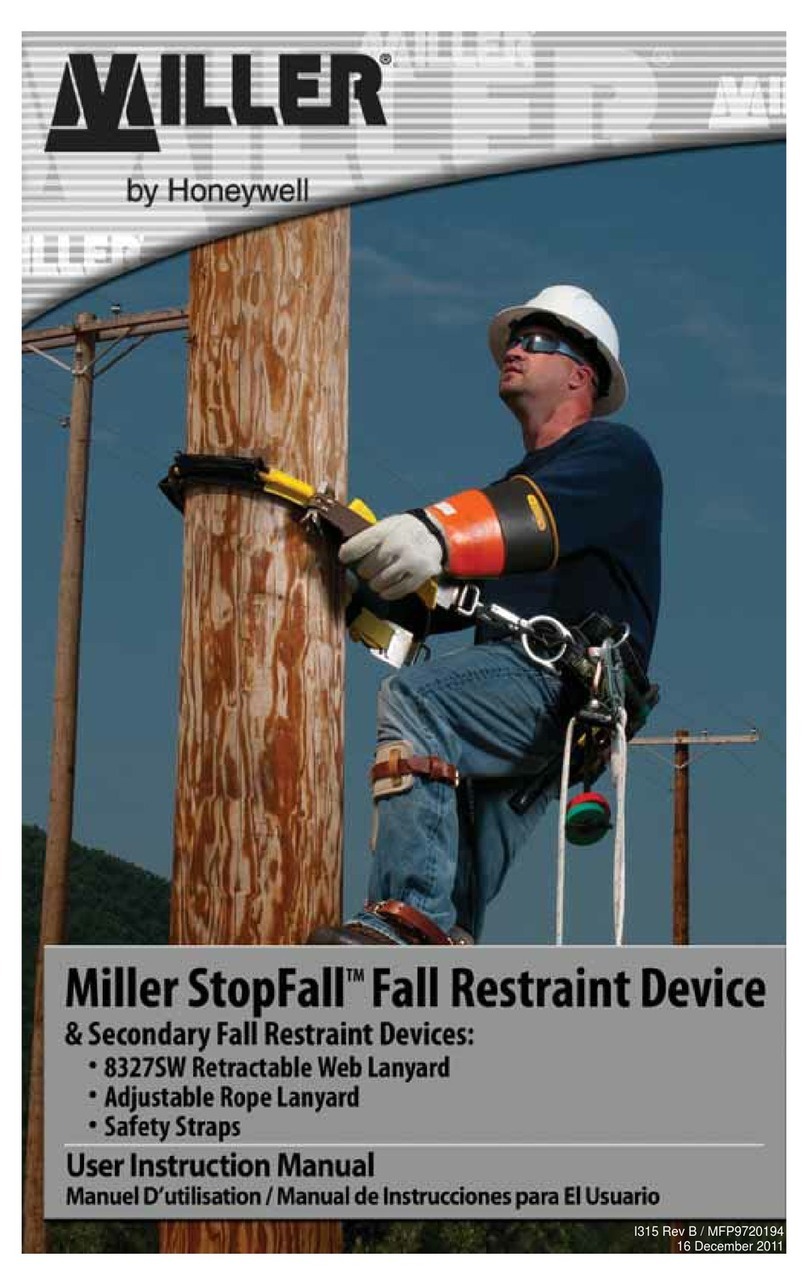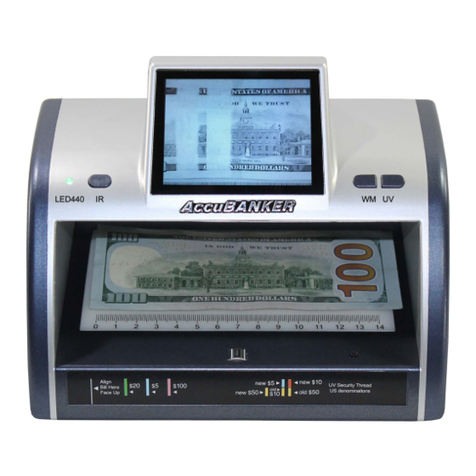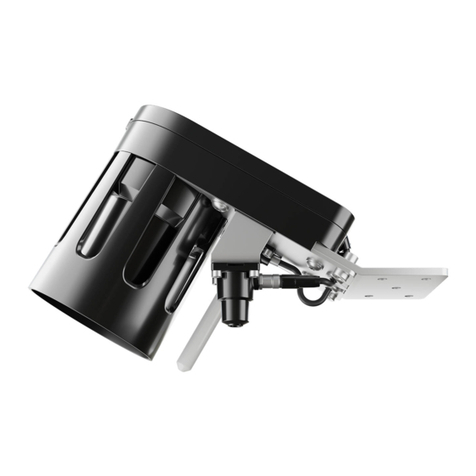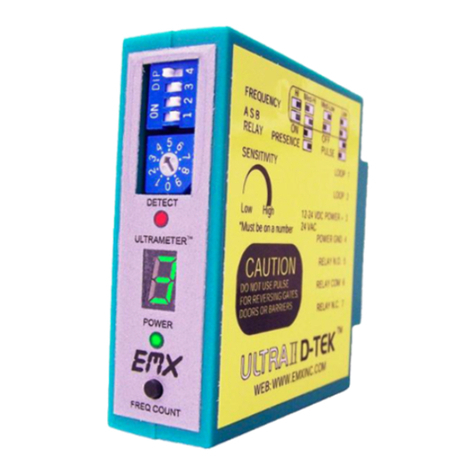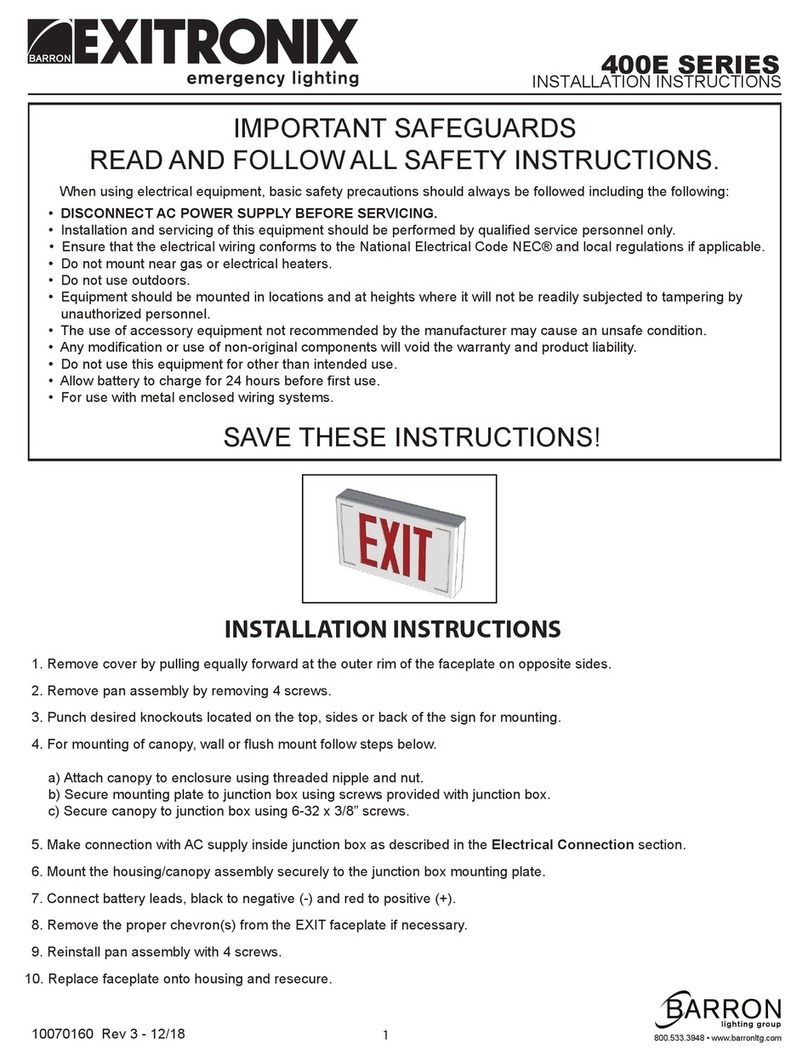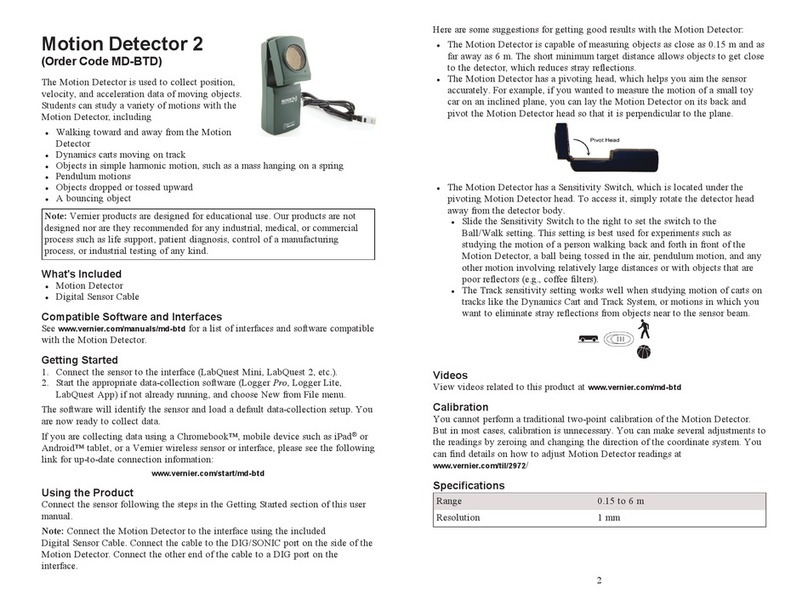Electronics Line EL-2800 User manual

Wireless PIR
Outdoor Detector
MODEL: EL-2800
INSTALLATION INSTRUCTIONS
EN
F
R
ES
PR
IT

2
EN

3
EN
Introduction
Electronic Line’s Wireless PIR Outdoor Detector is a unique detector with signal processing based
on two Passive Infrared (PIR) channels. The detector has an adjustable detection range. The
detector is compatible with all Electronic Line’s Wireless and Hybrid systems.
The following instructions describe the installation of the Wireless PIR Outdoor Detector.
Mounting
Mounting Considerations
1. Installation Height: 0.8m - 1.2m
(2'8" – 3'11")
Typical Installation Height: 1m (3'3")
2. To ensure maximum operational reliability, install the detector perpendicular to the ground so
that the upper detection area is parallel to the ground.
3. For optimum detection,
select a location that is likely
to intercept an intruder
moving across the coverage
pattern.
4. Avoid pointing the detector to moving
objects (swaying trees, bushes etc.)
Out of
Detection Range
With moving objects
keep distance of
minimum 5 meters (16')
5m (16')
5. Ensure any objects do not obstruct the field
of view. Pay attention to growing trees or
bushes, plants with big moving leaves etc.

4
EN
Installing the Wireless Outdoor PIR Detector in challenging situations
In the following situations, rapid and significant infrared radiation changes can happen in both
PIR channels together, resulting in false alarms and therefore care should be taken.
1. Situations in which metal and/or glass objects measuring over 70cm (2’4”) in height from the
ground are in the field of view of the detector (cars, metal gates, shutters, metal walls,
windows, etc.)
2. Situations in which a reflective surface on the ground larger than 1m (3’4”) in diameter may
cause reflection into the detector’s lens. Examples of a reflective surface on the ground are a
puddle, wet road or car park, smooth concrete or asphalt surface, swimming pool, etc.
Water Reflection
Notes:
1. Please note that any outdoor PIR detector will require reduction in range to a shorter distance than the car,
metal object or surface reflection (so that these objects won’t be protected) in order to eliminate false alarms.
2. For full 15m (50’) coverage in the above situations, it is highly recommended to install the Wired DT Outdoor
Detector, the only outdoor detector with 2 PIR channels and 2 Microwave channels.
3. Wireless Outdoor PIR detectors include high quality Silicon filters on the PIR sensors for blocking out white
light interferences. These filters are not intended to block infrared thermal radiation.

5
EN
Wall Mount Installation
Note:
The installation knockouts numbering are marked
on the back plate.
1. Open the Wireless PIR Outdoor Detector
front cover (unlock C1, Figure 1).
2. Release internal base (unlock I1, Figure
2).
3. Select mounting installation as follows:
Flat Mounting:
Open knockouts on external base (Figure
3).
•B1 - B4: Wall mounting knockouts
•T1: Back tamper knockout
45° angle Mounting (Left side
mounting):
a. Open knockouts on external base
(Figure 3).
•L1, L2: Left mounting knockouts
•T3: Left tamper knockout
b. Remove tamper spring (Figure 4).
c. Replace tamper bracket (Item 1) with
supplied flat tamper bracket (Item 2).
Item 1
Item 2
d. Insert Tamper lever B onto T6 and T3
and secure screw A (Figure 3).
4. Secure external base to the wall.
5. Insert tamper wires through internal base
(Figure 4).
6. Secure internal base to external base
(lock I1, Figure 2).
7. Close the front cover (Lock C1, Figure 1)
after wiring and setting DIP switches.
8. Walk test the detector.
Figure 1
C1
Figure 2
I1
Figure 3
Tamper
Lever
A
T5
T1
B2
W9
B3
W2
B
L1
T3
B1
L2
W3
B4
R1
R2
(not visible)
T2
T6
(not visible)
T4
W5
W6
Figure 4
Note:
For 45° right side installation use the equivalent units on the external base as follows:
Knockouts Description Lef
t
Righ
t
Mounting Knockouts L1, L2 R1, R2
Tamper spring knockouts T1,T3 T2,T4
Tamper screw anchor T5 T6

6
EN
Changing Back Tamper position:
The back tamper is by default secured on the right
side of the internal base (Rear view). If you wish to
move it to the left side (rear view), do the following
(Figure 5):
1. Remove tamper screw 1 in order to release the
tamper from position 7.
2. Ensure tamper spring (2) rests over tamper wire
base 4.
3. Ensure plastic tamper bracket (3) rests over
both 2 and 4.
4. Secure tamper screw (1) into (3) over position 6.
Figure 5
Left Side
Tamper
Right Side
Tamper
3
6
1
2
4
7
5
Notes:
1. Verify that you hear a "Click" when attaching the tamper spring to the wall.
2. For pole installation, the tamper can be moved to the bottom right-hand side of the internal base.

7
EN
Back Tamper Terminal Wiring
If you wish to use the back tamper (recommended) remove the short from the back tamper
terminal block and connect the back tamper wires to the back tamper terminal block.
Back Tamper in use
BACK TAMPER
Back Tamper not used
Short
H1 H1
DIP Switch Settings
DIP 1: LED operation
On: LED enabled
Off: LED disabled
DIP 2: PIR detection sensitivity
On: High
Off: Normal
DIP 3: Walk test mode
On: Alarm (every 3 Sec.)
Off: Alarm delay (every 2.5 Min.)
Note:
For Walk test, DIP 3 must be set to ON and then
set back to OFF for normal operation
DIP 4: Not used
DIP 5: Not used
DIP 6: Not used
Detection Range Adjustment
Slide the moving PIR to the desired
position, see figure 6.
The range of the lower detection area
determines the detection range.
The upper PIR is fixed and its detection
area is parallel to the ground at all times.
The lower detection area changes from
2m to 12m depending on the location of
the moving PIR. Therefore, the detection
range is established according to the
location of the lower PIR since both the
upper and the lower PIR should be
triggered in order to activate an alarm.
Figure 6

8
EN
Detection patterns (side view):
Detection range with 1m (3'3")
installation height:
*
Note:
Length may vary according to
environmental thermal conditions.
N
ote:
No effective detection occurs at distance
less than 2.5 ft from the detector.
Walk test
Two minutes after applying power, walk test the protected area to verify proper operation.
Adjust the moving PIR for required detection range and reliability.
Important!
Both upper and lower detection areas must be blocked simultaneously for detection to occur, see figure 7 below.

9
EN
Figure 7
LED Display
LED State Description
RED Steady Indicates ALARM
Operational Modes
Operational Mode Description
Normal Dead time (between detection alarms) is 2.5 Minutes.
Test (walk test) Dead time (between detection alarms) is 3 sec.
Note:
After power up the detector enters into test mode for a period of 20 minutes (disregarding the DIP Switch Modes
Position).
Transmitter/Receiver Communication link setup
The detector must identify itself to the control panel’s receiver by registering its coded message
into the receiver’s address memory. This is accomplished by performing the following steps:
1. Set the receiver to Registration Mode.
2. Remove the insulation material from the battery and place it in the battery holder on the PCB
on the right direction (pay attention to the "+" and "–" diagram on the PCB)
3. Send a registration message by closing both of the tamper switches (back and cover) for at
least 3 seconds.
4. Verify that the detector has been identified by the receiver.
Caution Notice
Changes or modifications not expressly approved by Electronics Line may void the user’s authority to operate
this equipment.
Simultaneous transmissions from two different units may cause message interference resulting in loss of
information.
The communication quality of this unit may be affected by its surrounding environment. Nearby electrical
equipment may interfere with its normal operation.
The operation of this unit must, therefore, be tested at each installation since its transmission quality may vary
as a result of operational conditions.

10
EN
Note:
DIP Switch 1 should be in ON position to enable LED indications (regardless during the first 20 minutes after
power up).
Optional Swivel Installation (Not Supplied)
Please follow the instructions below for mounting the detector with the Swivel:
1. Open the Wireless PIR Outdoor Detector front cover (Unlock C1, Figure 1).
2. Release internal base (Unlock I1, Figure 2).
3. Remove back tamper from the internal base (see the “Changing Back Tamper Position"
paragraph on page Error! Bookmark not defined.) and connect it to S5 (Figure 8, Detail A)
on the Standard Swivel.
4. Select the mounting installation as follows:
Note:
•The swivel mount has not been evaluated by UL
•Ensure that you see the engraved UP mark on the upper front face of the swivel.
Wall Mounting
1. Insert back tamper wires through the Swivel Wires Passage (Figure 8, Detail B).
2. Secure swivel to the wall through holes S1, S3, S6 and S8.
Detail B
S1
W1
S2
S3
Snaps
Detail C
S1 S2
S8
S6
S5
S4
Tamper
(see Detail C)
Detail A
Standard Swivel
Figure 8
3. Connect the external base to the swivel using the dedicated snaps (Figure 9).

11
EN
Figure 9
Note:
Do not open or close the Swivel Assy Screw since it is used for connecting the swivel parts only (factory
tightened).
4. Secure external base to swivel with two screws fastened trough knockouts S1 and S2
(Figure 9).
5. Insert the supplied angle locking screw from the external base through the angle locking
screw knockout S3 on the external base to the standard swivel (Figure 9).
6. Rotate the Standard Swivel to the desired position. Once the
Standard Swivel is in the desired position, secure the angle
locking screw.
Important!
Take care not to tilt the detector upwards and downwards. The
detector should remain perpendicular to the ground for maximum
detection and reliability.
7. Line up the internal base onto the external base. Insert tamper
wiring through the internal base.
8. Secure internal base to external base (Lock I1, Figure 2).
9. To readjust the Standard Swivel when the PCB is installed
(Figure 10):
a. Bend down the black foam located below the RED LED on
the PCB (enough to reach the Swivel locking screw).
b. Use a Hex screwdriver to release the locking screw (see
Figure 10).
c. Rotate the Swivel to the desired position.
d. Secure the angle locking screw.
Figure 10: PCB

12
EN
Note:
When marks on the two movable parts are aligned (Figure 9), the Standard Swivel is in 0°vertical/horizontal
position. Each click from this position represents shifting of 5°in vertical/horizontal position.
10. Close the front cover (Lock C1, Figure 1) and walk test the detector.
Note:
The screw has to pass through the External Base and locked to the swivel.
Replacing Lenses
1. Unlock the six screws that hold the lens holding sleeve from the back of the front cover.
2. To release the protective sleeve, gently push the lens from the external side of the front cover.
3. Disconnect the lens from the sleeve by gently pushing the lens clips that secure it to the
sleeve.
4. Replace the lens. Place the 4 clips of the lens into the matching holes on the sleeve.
5. Insert the protective sleeve back into place on the front cover. Pay attention to place the
sleeve over the sealing rubber.
6. Secure the 6 holding screws back to their place.
Lens Protecting
Sleeve
Sockets for
Lens Clips
Sleeve Locking
Screws
.
Lens Locking
Clips
Sealing Rubber
Front Cover
Locking Screw
Figure 11

13
EN
Technical Specification
Electrical
Current consumption
(standby)
20uA at 3 VDC (average)
Current consumption
(Alarm transmission)
43mA at 3 VDC (Max. with LED OFF)
53mA at 3 VDC (Max. with LED ON)
Dead time (Normal Mode) 2.5 minutes
Modulation type FM
Battery life 3 years (upon usage)
Range 300m (1000 feet) Line of Sight
Battery 1 x CR123A 3VDC Lithium Battery
* Use only the following CR123A batteries:
DURACELL DL123A,
GP GPCR123A,
PANASONIC CR123A,
SANYO CR123A,
VARTA CR123A,
EVE Energy CR123A
Frequency 433 / 868MHz
Physical
Size (LxWxD) 230 x 121 x 123mm (9 x 4.76 x 4.85 in.)
Environmental
Operating/Storage
temperature
-25°C to 60°C (-13°F to 140°F)
* PIR technology is limited in harsh environmental conditions.
RF immunity According to EN50130-4
* Specifications are subject to change without prior notice.
Ordering Information
Model Description
E8US048WXP0A EL2800 Wireless Outdoor PIR 868
E4US048WXP0A EL2800 Wireless Outdoor PIR 433
Accessory Kits
Model Description Weight
RA300S00000A Standard Swivel Kit 0.21 Kg (0.46 lb)
RA300P Pole Adaptor Kit 0.25 Kg (0.55 lb)
RTTE Compliance Statement
Hereby, Electronics Line declares that this equipment is in compliance with the essential
requirements and other relevant provisions of Directive 1999/5/EC. For the CE Declaration of
Conformity please refer to our website: www.electronics-line.com.

14
EN

1
IT
Rivelatore PIR da
Esterno Via Radio
MODELLO: EL-2800
ISTRUZIONI DI INSTALLAZIONE

2
IT

3
IT
Introduzione
Il rivelatore da esterno ad infrarosso passivo PIR Radio di Electronic Line (EL-2800) è un
dispositivo a microprocessore che elabora i segnali rilevati tramite due canali all’infrarosso
passivo (PIR). Il EL-2800 ha un’area di copertura regolabile. Il rivelatore è compatibile con tutti i
sistemi radio ed ibridi Electronic Line.
Le istruzioni che seguono descrivono le procedure per l’installazione del EL-2800.
Installazione
Considerazioni preliminari
1. Altezza possibile: da 0.8m a 1.2m
Altezza tipica: 1m
Angolo di copertura: 90°
2. Per ottenere la migliore condizione di funzionamento ed affidabilità, installare il rivelatore
perpendicolare al terreno in modo che la zona di rilevazione superiore sia parallela al terreno.
3. Per una migliore rivelazione
selezionare una posizione
di installazione in modo che
l’eventuale intruso attraversi
l’area di copertura.
4. Evitare di direzionare l’unità verso oggetti in
movimento (alberi ondeggianti, cespugli, ecc.)
Mantenere una distanza
di almeno 5m (16') da
oggetti in movimento
Fuori campo di
rilevazione
5m (16')
5. Assicurarsi che nessun oggetto ostruisca il
campo di rilevazione dell’unità. Prestare
attenzione alla crescita di alberi, rami e ad
eventuali altre piante che con il tempo
possono coprire l’area di rilevazione.

4
IT
Installazione del EL-2800 in situazioni critiche:
Nelle seguenti situazioni variazioni delle radiazioni all’infrarosso rapide e rilevanti possono far si
che entrambi i canali PIR si attivino contemporaneamente, con conseguenti falsi allarmi.
1. Situazioni in cui oggetti riflettenti di vetro e/o metallo di dimensioni superiori ai 70 cm di
altezza da terra siano nel campo visivo del rivelatore (automobili, cancelli metallici,
saracinesche, muri metallici, finestre, etc.).
2. Situazioni in cui una superficie riflettente a terra con un diametro maggiore di 1m possa
causare un riflesso nelle lenti del rivelatore. Per esempio una piscina, una pozzanghera, la
strada bagnata, asfalto o cemento molto liscio.
Riflesso dell’acqua
NOTE:
1. Si noti che qualsiasi rivelatore PIR da esterno, per evitare falsi allarmi, richiede una riduzione di portata al
fine di evitare di proteggere superfici riflettenti come auto, oggetti metallici o pozzanghere.
2. Per ottenere una copertura completa nelle installazioni critiche sopra descritte, si raccomanda di installare
il WatchOUT DT cablato, l’unico rivelatore da esterno con 2 canali PIR e 2 canali a microonde.
3. I rivelatori WatchOUT includono sui sensori PIR dei filtri al silicone di elevata qualità per filtrare le
interferenze causate dalle luci bianche. Questi filtri non bloccano le radiazioni termiche ad infrarossi
necessarie per la rilevazione degli intrusi.

5
IT
Installazione a parete
NOTA:
I numeri di riferimento dei fori a sfondare per
l’installazione sono marcati sulla base posteriore.
1. Aprire il coperchio frontale del EL-2800
(Svitare C1, Figura 1).
2. Sganciare la base interna (svitare I1, Fig.
2).
3. Selezionare l’altezza di installazione
come segue:
Installazione piana:
Aprire i fori a sfondare della base esterna
(Fig.3)
•B1 - B4: Fori a sfondare per
installazione a parete
•T1: Foro a sfondare per il tamper
antirimozione
Installazione angolare di 45°
(installazione a sinistra):
a. Aprire i fori a sfondare della base
esterna
(Figura 3)
•L1, L2: Fori a sfondare per lato
sinistro
•T3: Foro a sfondare per tamper lato
sinistro
b. Rimuovere la molla del tamper
c. Sostituire la staffa 1 del tamper con la
staffa piana 2 del tamper, fornita
Item 1
Item 2
d. Inserire la leva B del tamper in T5 e T3
e stringere la vite A (figura 3).
4. Assicurare la base esterna alla parete.
5. Inserire i cavi esterni e i cavi del tamper
attraverso la base interna (Figura 4)..
6. Assicurare la base interna a quella
esterna (bloccare I1, Figura 2).
7. Chiudere il coperchio frontale (bloccare
C1, figura 1) dopo aver predisposto i
microinterruttori.
8. Effettuare le prove di copertura.
Figura 1
C1
Figura 2
I1
Figura 3
Leva del
Tamper
A
T5
T1
B2
W9
B3
W2
B
L1
T3
B1
L2
W3
B4
R1
R2
(non visibile)
T2
T6
(non visibile)
T4
W5
W6
Figura 4
NOTA:
Per l’installazione angolare a 45° sul lato destro del rivelatore, usare i riferimenti riportati sulla plastica della
base come da tabella seguente, colonna destra:
Descrizione fori a sfondare Sinistra Destra
Fori a sfondare per il fissaggio della base L1, L2 R1, R2
Fori a sfondare molla tamper T1,T3 T2,T4
Punto fissaggio vite Tamper T5 T6

6
IT
Modifica della posizione del tamper
antirimozione:
Di fabbrica il tamper antirimozione è fissato sul lato
destro della base interna (vista posteriore). Se si
desidera spostarlo nella parte sinistra (vista
posteriore), procedere come segue (Figura 5):
1. Svitare la vite del tamper 1 per rimuoverlo dalla
posizione 7.
2. Assicurarsi che la molla 2 del tamper resti
posizionata sulla base 4 del tamper.
3. Assicurarsi che la staffa 3 del tamper resti tra 2 e 4.
4. Fissare la vite 1 del tamper in 3 sulla
predisposizione 6.
Figura 5
1
3
6
7
5
4
2
Predisposizione
tamper a sinistra Predisposizione
tamper a destra
N
OT
A
:
1. Verificare che si senta un "Click" quando la molla del tamper viene spinta verso il muro.
2. Per l’installazione su palo il tamper può essere spostato nella parte inferiore destra della base interna.
Cablaggio del tamper antirimozione
Se si desidera usare l’interruttore del tamper antirimozione (consigliato) rimuovere il cortocircuito
dai morsetti del tamper antirimozione e collegare il filo dell’interruttore antirimozione ai morsetti
dedicati al tamper antirimozione.
Utilizzo del tamper
antirimozione
TAMPER ANTIRIMOZIONE
Tamper antirimozione
non utilizzato
Cortocircuito
H1 H1
Predisposizione Microinterruttori
MIC. 1: Predisposizione LED
On: LED abilitati
Off: LED disabilitati
MIC. 2: Sensibilità di rilevazione PIR
On: Alta
Off: Normale
MIC. 3: Cammina modalità di prova
On: Allarme (ogni 3 sec.)
Off: Ritardo di allarme (ogni 2.5 min)
Note:
Per la prova Walk, DIP 3 deve essere impostato
su ON e quindi impostare di nuovo su OFF per il
normale funzionamento.
MIC. 4: Non usata
MIC. 5: Non usata
MIC. 6: Non usata
Table of contents
Languages:
Other Electronics Line Security Sensor manuals

Electronics Line
Electronics Line EL5845 User manual
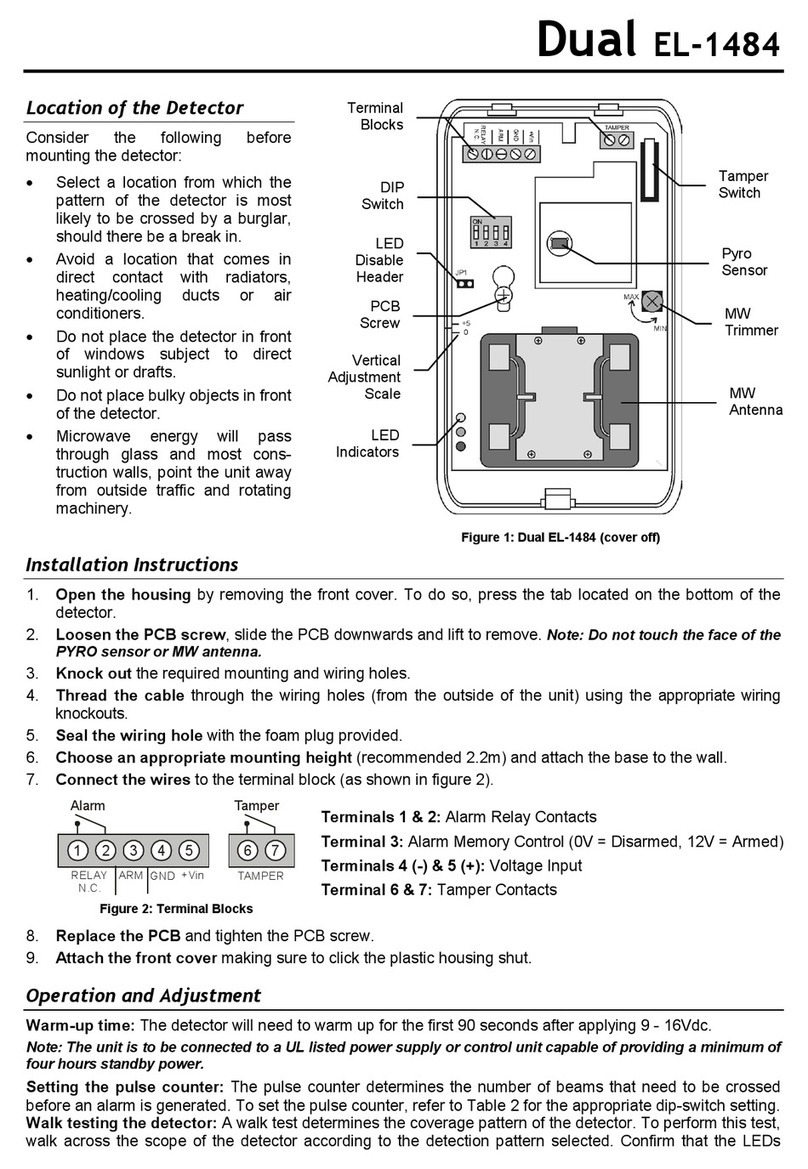
Electronics Line
Electronics Line EL-1484 User manual

Electronics Line
Electronics Line EL-4755 User manual
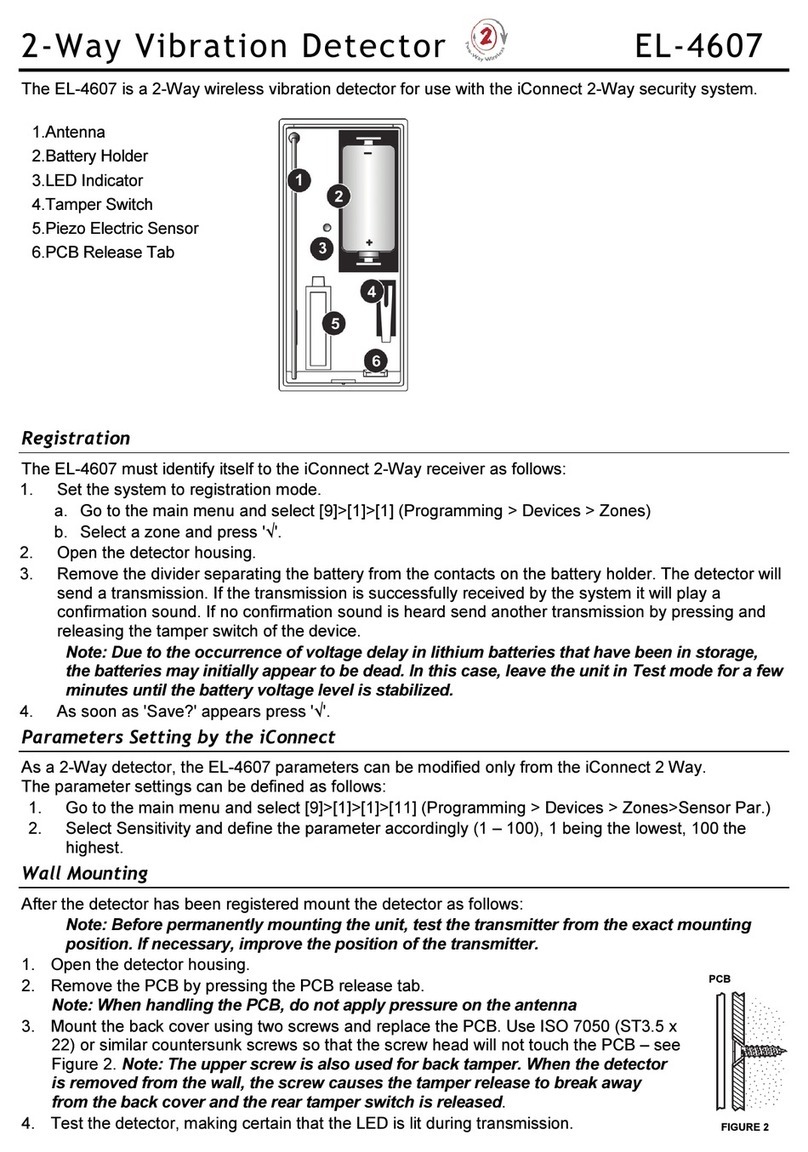
Electronics Line
Electronics Line EL-4607 User manual
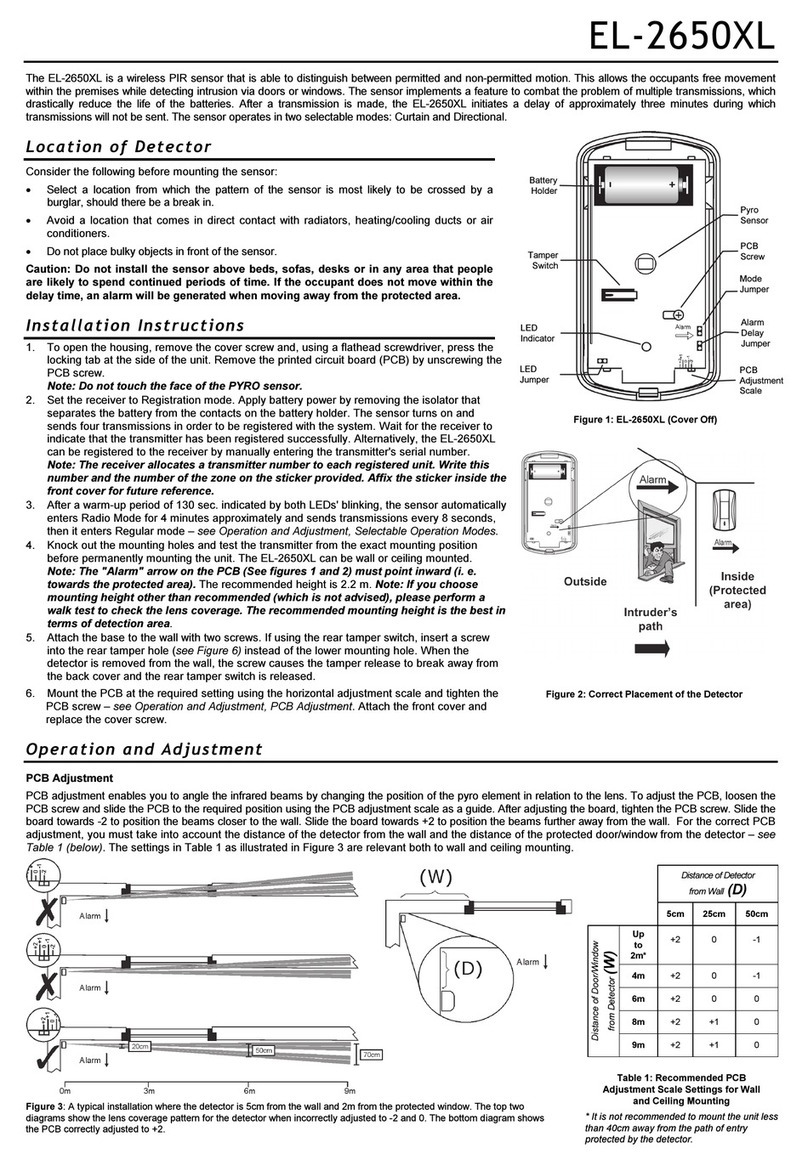
Electronics Line
Electronics Line EL-2650XL User manual
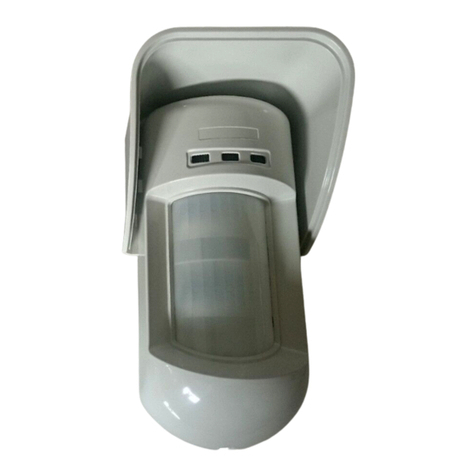
Electronics Line
Electronics Line EL-4800 User manual
Popular Security Sensor manuals by other brands
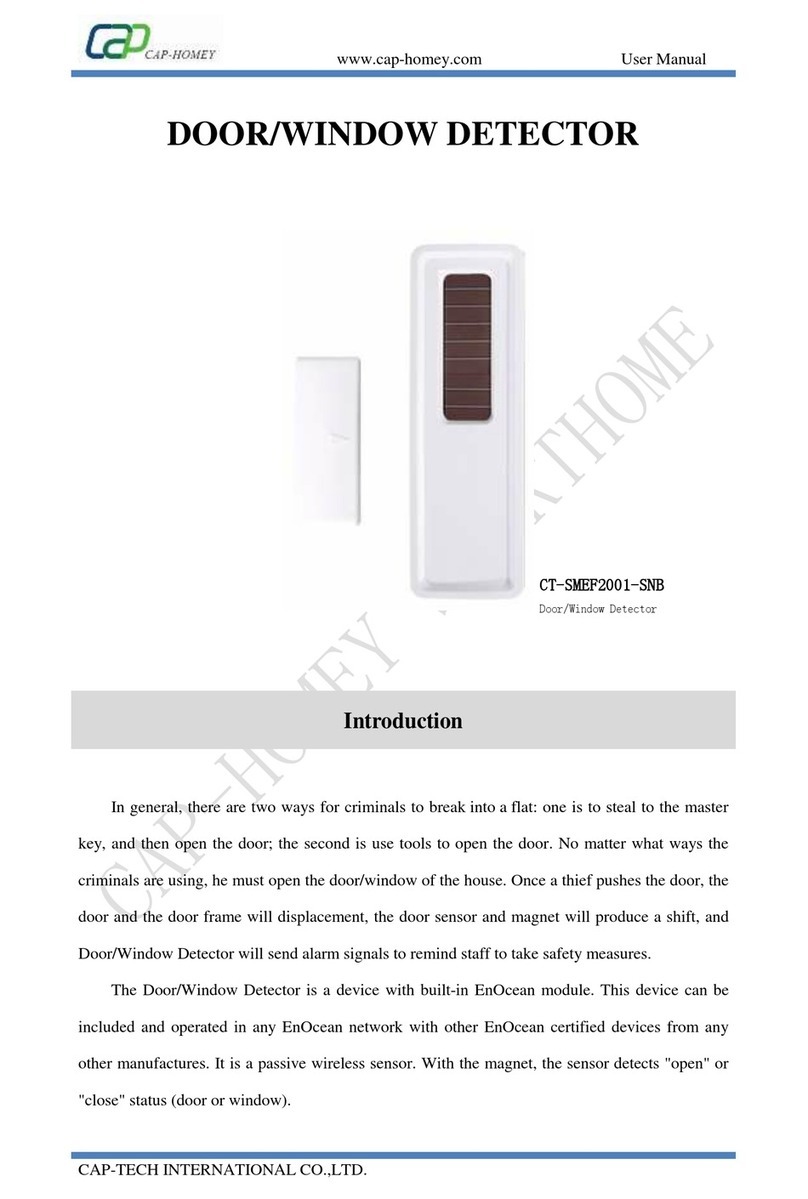
CAP-HOMEY
CAP-HOMEY CT-SMEF2001-SNB user manual
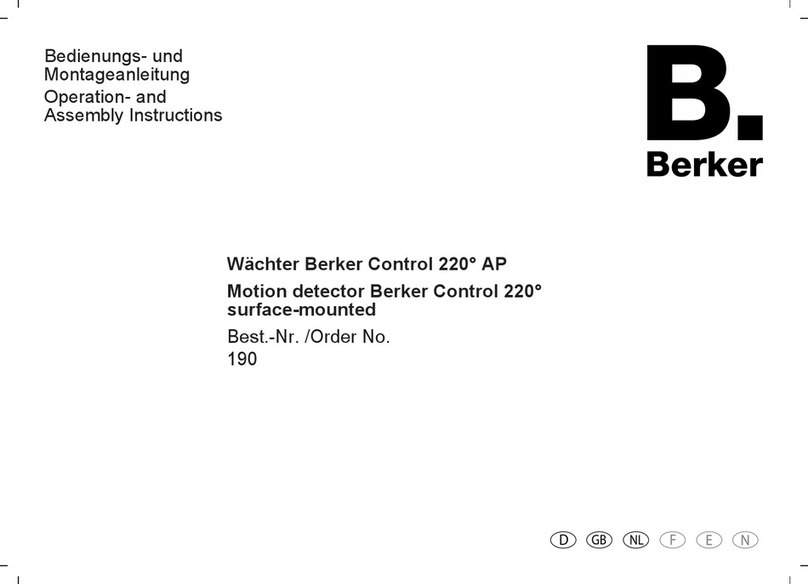
Berker
Berker Control 220 Operation and assembly instructions

urmet domus
urmet domus 1033 Installation and instruction manual
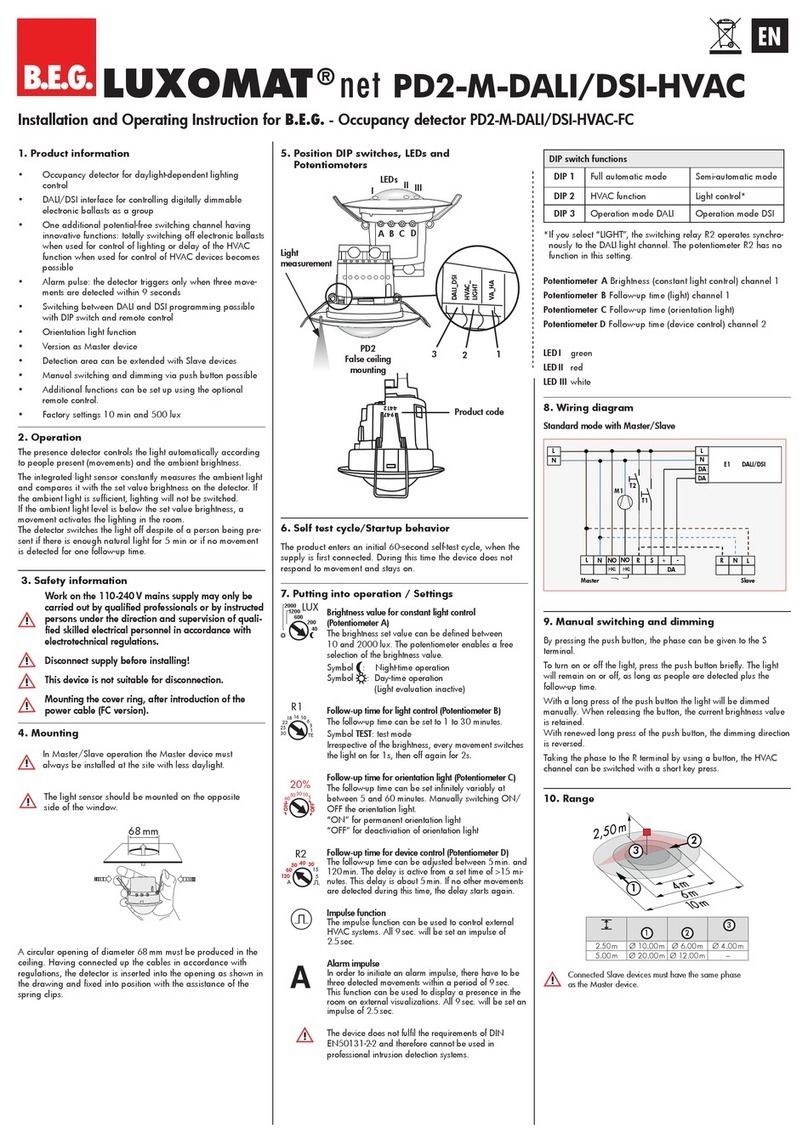
LUXOMAT
LUXOMAT PD2-M-DALI/DSI-HVAC Installation and operating instruction
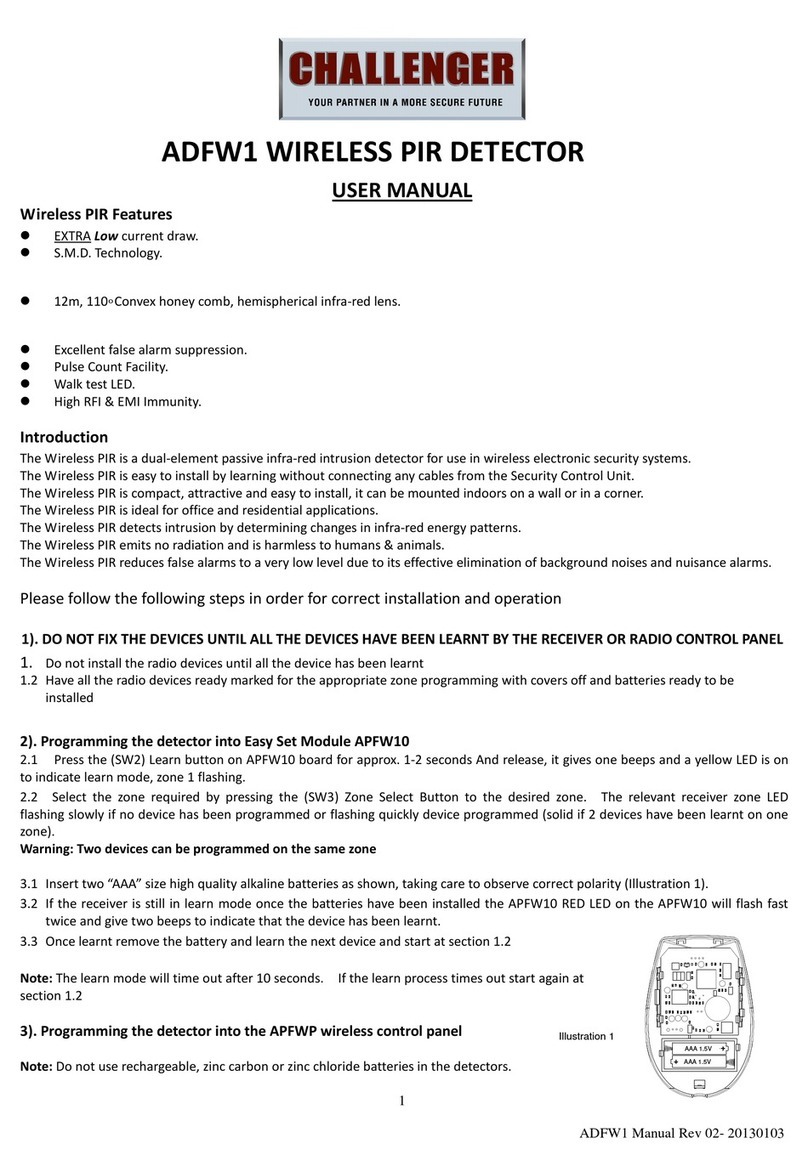
Challenger
Challenger ADFW1 user manual
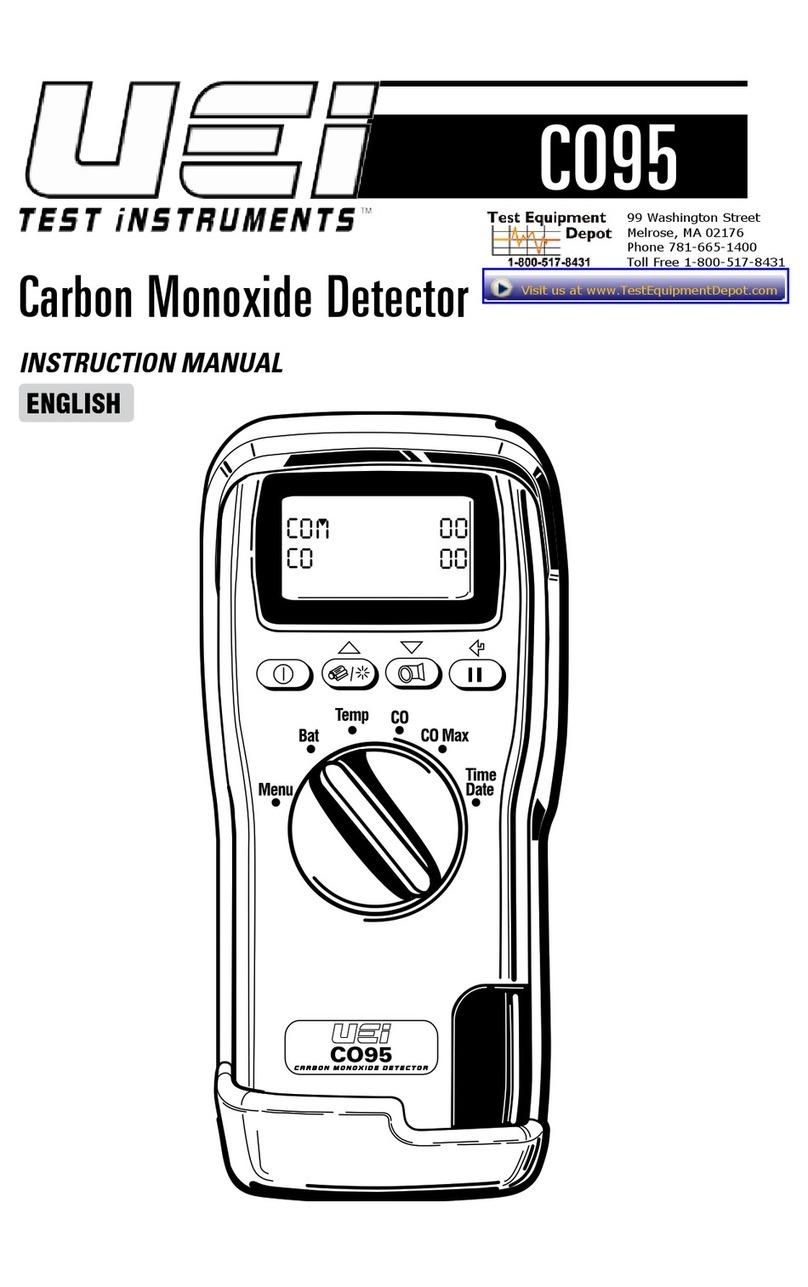
UEi
UEi CO95 instruction manual


